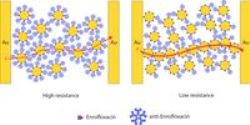Biosensors are devices that are used to detect the presence of a compound in a mixture containing other compounds. The portable devices make use of biological molecules for detection and find application in daily processes such as testing of drinking water for contamination, pregnancy tests and testing blood-sugar levels.
 Biochemiresistors
Biochemiresistors
Researchers at University of New South Wales have developed a new biosensor referred to as a biochemiresistor that is much more sensitive and much faster than traditional biosensors. The researchers claim an ability to detect levels as low as 1 nanogram in a liter of the sample and a response time of just 40 minutes.
Their work has been published in the chemistry journal Angewandte Chemie and has been labeled as a “Very Important paper”, a distinction that is offered only to about 5% of the published work. The study’s co-author, Scientia Professor Justin Gooding, of the UNSW School of Chemistry and the Australian Centre for Nanomedicine, described the research work carried out wherein the biochemiresistor was used to detect the presence of the agricultural antibiotic Enrofloxacin in milk. The biochemiresistor consists of magnetic nanoparticles coated with gold and antibodies specific to the chemical component or analyte they are testing for. When the nanoparticles are introduced into the sample solution, the antibodies attach themselves to the analyte present, thereby lowering the resistance of the nanoparticles. The nanoparticles are then aligned between two electrodes using magnets and the electrical resistance is measured. Greater the analyte concentration, lower is the resistance of the nanoparticle film.
The reasons for the ultra-sensitivity and quick response time are due to the entire sample being subject to analysis rather than just small portions and bringing the analyte to the magnetic nanoparticle sensors rather than wait for the analyte to reach the sensor, respectively.